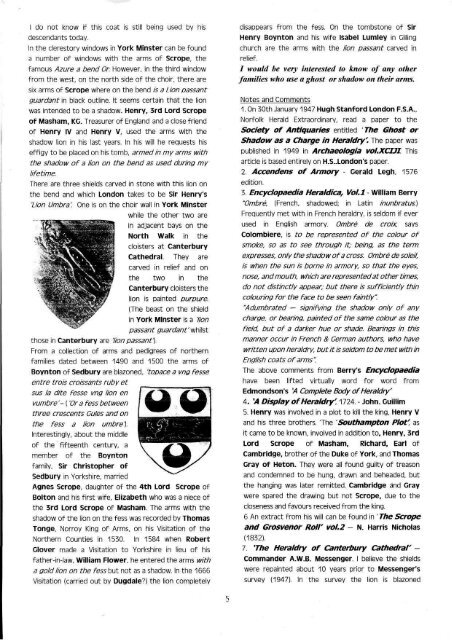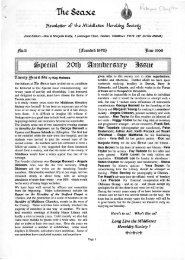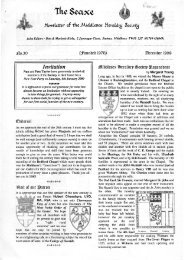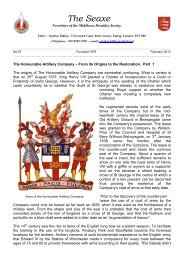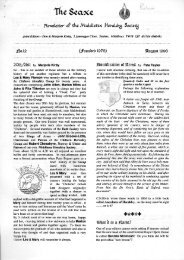The Seaxe - Middlesex Heraldry Society
The Seaxe - Middlesex Heraldry Society
The Seaxe - Middlesex Heraldry Society
You also want an ePaper? Increase the reach of your titles
YUMPU automatically turns print PDFs into web optimized ePapers that Google loves.
I do not know if this coat is still being used by his<br />
descendants today.<br />
In the clerestory windows in York Minster can be found<br />
a number of windows with the arms of Scrope, the<br />
famous Azure a bend Or. However, in the third window<br />
from the west, on the north side of the choir, there are<br />
six arms of Scrope where on the bend is a Lion passant<br />
guardant in black outline. It seems certain that the lion<br />
was intended to be a shadow. Henry, 3rd Lord Scrope<br />
of Masham, KG. Treasurer of England and a close friend<br />
of Henry iv and Henry v, used the arms with the<br />
shadow lion in his last years. In his will he requests his<br />
effigy to be placed on his tomb, armed in my arms with<br />
the shadow of a lion on the bend as used during my<br />
lifetime.<br />
<strong>The</strong>re are three shields carved in stone with this lion on<br />
the bend and which London takes to be Sir Henry's<br />
'Lion Umbra'. One is on the choir wall in York Minster<br />
while the other two are<br />
in adjacent bays on the<br />
North Walk in the<br />
cloisters at Canterbury<br />
Cathedral. <strong>The</strong>y are<br />
carved in relief and on<br />
the two in the<br />
Canterbury cloisters the<br />
lion is painted purpure.<br />
(<strong>The</strong> beast on the shield<br />
in York Minster is a 'lion<br />
passant guardant 'whilst<br />
those in Canterbury are 7/dn passant).<br />
From a collection of arms and pedigrees of northern<br />
families dated between 1490 and 1500 the arms of<br />
Boynton of Sedbury are blazoned, 'topace a vng fesse<br />
entre trois croissants ruby et<br />
sus la dite fesse vng lion en<br />
vumbre' - ('Or a fess between<br />
three crescents Gules and on<br />
the fess a lion umbre).<br />
Interestingly, about the middle<br />
of the fifteenth century, a<br />
member of the Boynton<br />
family, Sir Christopher of<br />
Sedbury in Yorkshire, married<br />
Agnes Scrope, daughter of the 4th Lord Scrope of<br />
Bolton and his first wife, Elizabeth who was a niece of<br />
the 3rd Lord Scrope of Masham. <strong>The</strong> arms with the<br />
shadow of the lion on the fess was recorded by Thomas<br />
Tonge, Norroy King of Arms, on his Visitation of the<br />
Northern Counties in 1530. In 1584 when Robert<br />
Glover made a Visitation to Yorkshire in lieu of his<br />
father-in-law, William Flower, he entered the arms with<br />
a gold lion on the fess but not as a shadow. In the 1666<br />
Visitation (carried out by Dugdale?) the lion completely<br />
5<br />
disappears from the fess. On the tombstone of Sir<br />
Henry Boynton and his wife Isabel Lumley in Gilling<br />
church are the arms with the lion passant carved in<br />
relief.<br />
I would be very interested to know of any other<br />
families who use a ghost or shadow on their arms.<br />
Notes and Comments<br />
1. On 30th January 1947 Hugh Stanford London F.S.A.,<br />
Norfolk Herald Extraordinary, read a paper to the<br />
<strong>Society</strong> of Antiquaries entitled ' <strong>The</strong> Ghost or<br />
Shadow as a Charge in <strong>Heraldry</strong>'. <strong>The</strong> paper was<br />
published in 1949 in Archaeologia vol.XCIII This<br />
article is based entirely on H.S. London's paper.<br />
2. Accendens of Armory - Gerald Legh, 1576<br />
edition.<br />
3. Encyclopaedia Heraldica, Vol.1 - William Berry<br />
"Ombre, (French, shadowed; in Latin inunbratus.)<br />
Frequently met with in French heraldry, is seldom if ever<br />
used in English armory. Ombre de croix, says<br />
Colombiere, is to be represented of the colour of<br />
smoke, so as to see through it; being, as the term<br />
expresses, only the shadow of a cross. Ombre de soleil,<br />
is when the sun is borne in armory, so that the eyes,<br />
nose, and mouth, which are represented at other times,<br />
do not distinctly appear; but there is sufficiently thin<br />
colouring for the face to be seen faintly".<br />
"Adumbrated — signifying the shadow only of any<br />
charge, or bearing, painted of the same colour as the<br />
field, but of a darker hue or shade. Bearings in this<br />
manner occur in French & German authors, who have<br />
written upon heraldry, but it is seldom to be met with in<br />
English coats of arms".<br />
<strong>The</strong> above comments from Berry's Encyclopaedia<br />
have been lifted virtually word for word from<br />
Edmondson's "A Complete Body of <strong>Heraldry</strong>'<br />
4. 'A Display of <strong>Heraldry</strong>'. 1724 - John. Guillim<br />
5. Henry was involved in a plot to kill the king, Henry V<br />
and his three brothers. '<strong>The</strong> Southampton Plot', as<br />
it came to be known, involved in addition to, Henry, 3rd<br />
Lord Scrope of Masham, Richard, Earl of<br />
Cambridge, brother of the Duke of York, and Thomas<br />
Gray of Heton. <strong>The</strong>y were all found guilty of treason<br />
and condemned to be hung, drawn and beheaded, but<br />
the hanging was later remitted. Cambridge and Gray<br />
were spared the drawing but not Scrope, due to the<br />
closeness and favours received from the king.<br />
6 An extract from his will can be found in ' <strong>The</strong> Scrope<br />
and Grosvenor Roll' vol.2 - N. Harris Nicholas<br />
(1832).<br />
7. '<strong>The</strong> <strong>Heraldry</strong> of Canterbury Cathedral' -<br />
Commander A.W.B. Messenger. I believe the shields<br />
were repainted about 10 years prior to Messenger's<br />
survey (1947). In the survey the lion is blazoned


